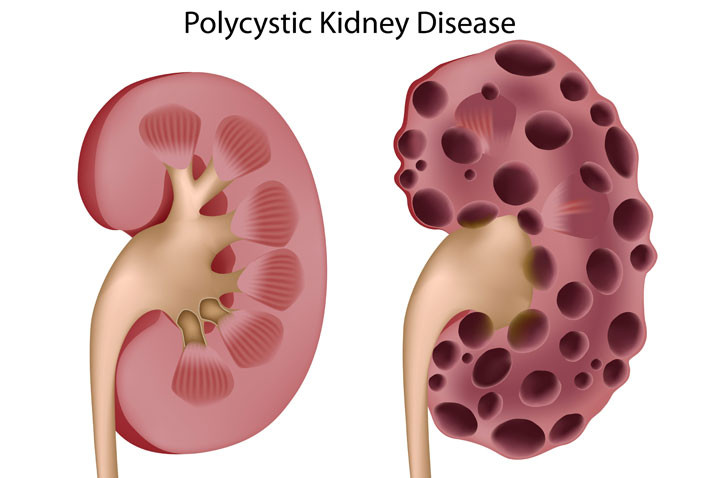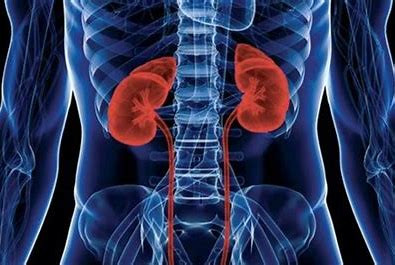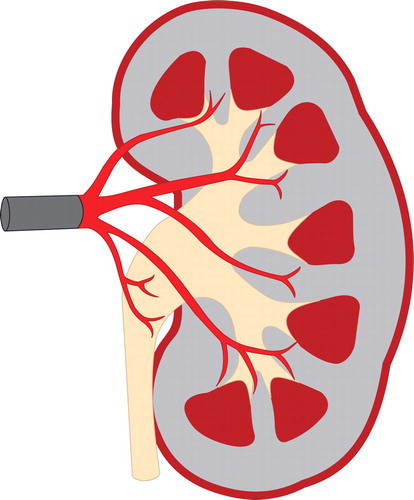Definisi
Penyakit ginjal polikistik adalah penyakit ginjal yang diturunkan secara familial atau genetik. Pada penyakit ini, banyak kista berisi cairan terbentuk di organ ginjal dan menyebabkan pembesaran pada organ ginjal. Kondisi medis ini dapat menganggu kinerja dari organ ginjal dan dapat menimbulkan gagal ginjal.
Penyakit ginjal polikistik menempati urutan keempat sebagai penyebab dari gagal ginjal. Pasien dengan penyakit ginjal polikistik dapat menimbulkan kista pada organ lainnya seperti liver, pankreas, dan limpa, beserta komplikasi lainnya.
Pada populasi dewasa, penyakit ginjal polikistik adalah penyakit yang disebabkan oleh genetik dan paling sering menyebabkan gagal ginjal dengan 6-8% pasien menjalani dialisis (cuci darah) di Amerika Serikat. Pada populasi usia 60 tahun, 50% dari mereka membutuhkan terapi pengganti ginjal. Kista dapat dideteksi pada usia anak-anak atau saat di dalam kandungan, namun gejala klinis biasanya baru muncul saat memasuki usia 30-40 tahun.
Berdasarkan data register klinis, laju angka kejadian dari ginjal polikistik berkisar 1 dari 543 hingga 1 dari 4000 kasus berhasil terdiagnosis. Hampir 4-7 juta orang yang menderita penyakit ini dan menyebabkan 7-15% pasien menjalani terapi pengganti ginjal. Proporsi penyakit ginjal stadium akhir yang disebabkan oleh ginjal polikistik lebih rendah kejadiannya pada populasi ras Afrika Amerika dibandingkan dengan ras berkulit putih. Gejala biasanya muncul seiring bertambahnya usia. Populasi anak sangat jarang mengalami gagal ginjal akibat ginjal polikistik dan penyakit ini sedikit lebih berat pada jenis kelamin laki-laki dibandingkan dengan perempuan.
Penyebab
Penyakit ginjal polikistik umumnya disebabkan oleh keturunan. Pada kasus yang jarang, seseorang dapat mengalami ginjal polikistik akibat masalah ginjal serius lainnya. Ada tiga tipe dari penyakit ginjal polikistik.
- Tipe Pertama, Disebut dengan Autosomal Dominan, atau penyakit ginjal polikistik dewasa. Berdasarkan panduan dari National Kidney Foundation, penyakit ini berperan dalam 90% kasus. Jika salah satu orang tua memiliki penyakit ginjal polikistik jenis autosomal dominan, maka anak memiliki kemungkinan sebesar 50% untuk menderita penyakit tersebut. Gejala biasanya berkembang seiring berjalannya usia, diantara usia 30-40 tahun. Namun, pada beberapa kasus, gejala dapat timbul saat usia anak-anak.
- Tipe Kedua, disebut dengan Autosomal Resesif. Tipe ini termasuk yang jarang terjadi namun dapat muncul apabila kedua orang tua memiliki gen penyakit ini. Orang dengan pembawa autosomal resesif tidak akan mengalami gejala apabila hanya memiliki satu gen dari orang tua. Apabila masing-masing dari orang tua membawa gen autosomal resesif, maka anak memiliki kemungkinan 25% mengalami penyakit ginjal polikistik.
- Tipe Ketiga, Disebut dengan Penyakit Ginjal Polikistik Didapat. Penyakit ini tidak diturunkan. Biasanya muncul pada usia dewasa. Seseorang dapat mengalami penyakit ini apabila sudah memiliki riwayat masalah ginjal sebelumnya. Penyakit ini umumnya muncul pada pasien yang telah mengalami gagal ginjal atau sedang dalam terapi cuci darah (dialisis)
.
Faktor Risiko
Faktor risiko yang berperan dalam munculnya ginjal polikistik simtomatik adalah faktor genetik, terutama adanya riwayat keluarga yang mengalami penyakit ini. Selain itu, ras kulit putih memiliki risiko lebih besar mengalami penyakit ginjal polikistik simtomatik meskipun belum diketahui secara pasti mekanismenya.
Gejala
Banyak penderita dengan penyakit ginjal polikistik tidak memiliki gejala yang berkaitan dengan organ ginjal selama bertahun-tahun. Kista umumnya bertumbuh sekitar 0,5 inci atau lebih besar sebelum penderita mulai menyadari adanya gejala.
Beberapa gejala awal yang dapat dirasakan oleh pasien dengan penyakit ginjal polikistik, yaitu:
- Nyeri tekan atau sakit pada perut
- Tekanan darah tinggi
- Tampak darah pada urine
- Lebih sering buang air kecil
- Nyeri pada pinggang
- Infeksi saluran kemih
- Batu ginjal
- Rasa nyeri atau berat pada punggung
- Kulit yang mudah memar
- Warna kulit pucat
- Mudah lelah
- Nyeri sendi
- Kelainan pada kuku
Pada populasi anak dengan ginjal polikistik, beberapa gejala yang dapat ditemukan antara lain tekanan darah yang tinggi, infeksi saluran kemih, dan lebih sering untuk buang air kecil. Gejala yang dikenali pada usia anak dapat menyerupai gejala dari penyakit lain. Hal ini penting untuk mendapatkan perhatian secara medis apabila anak mengalami beberapa gejala seperti diatas.
Diagnosis
Diagnosis ginjal polikistik adalah diagnosis yang dapat ditegakkan melalui wawancara medis, pemeriksaan fisik, hingga pemeriksaan penunjang bila tersedia dan perlu untuk dilakukan.
Pada wawancara medis, dokter akan menanyakan gejala yang dirasakan oleh pasien saat ini. Gejala-gejala yang ada dapat mengarahkan ke suatu penyakit tertentu sehingga Anda perlu mengutarakan gejala yang dirasakan selengkap mungkin disertai dengan sejak kapan gejala tersebut mulai dirasakan. Informasi ini penting bagi dokter dalam rangka menegakkan diagnosis medis tertentu. Apabila gejala yang dirasakan mengarahkan ke ginjal polikistik, maka dokter akan melanjutkan ke pemeriksaan fisik dan pemeriksaan penunjang.
Pada pemeriksaan fisik, dokter akan melakukan pemeriksaan sesuai dengan gejala yang dirasakan oleh pasien sehingga dapat ditemukan beberapa tanda klinis yang merupakan tanda objektif yang didapatkan oleh dokter melalui pemeriksaan fisik.
Pada kasus ginjal polikistik, dokter dapat menemukan adanya rasa nyeri tekan pada area pinggang atau perut.
Pemeriksaan penunjang juga memiliki peran dalam menegakkan atau memastikan diagnosis dari ginjal polikistik. Pemeriksaan penunjang seperti pemeriksaan darah lengkap untuk menilai adanya anemia, atau tanda infeksi dan urinalisis lengkap untuk mengetahui apakah ada darah, bakteri, atau protein di dalam urine.
Pemeriksaan pencitraan termasuk pemeriksaan USG untuk menilai apakah ada kista pada ginjal, CT scan untuk menilai apakah ada kista paling kecil pada ginjal, MRI scan untuk menilai struktur ginjal dan kista hingga pyelogram intravena untuk mengetahui gambaran pembuluh darah sekitar ginjal dapat dilakukan untuk membantu dalam menegakkan diagnosis ginjal polikistik.
Tata Laksana
Tujuan terapi pada penyakit ginjal polikistik adalah mengontrol gejala dan menghindari dari komplikasi yang mungkin muncul. Mengendalikan tekanan darah yang tinggi adalah bagian terpenting dari tata laksana. Beberapa pengobatan yang mungkin diberikan adalah obat tekanan darah tinggi, diet rendah natrium, diuretik untuk membuang kelebihan cairan dari tubuh hingga pembedahan untuk menghilangkan kista dan membantu untuk meringakan gejala.
Komplikasi
Komplikasi yang dapat muncul pada penyakit ginjal polikistik yaitu:
- Penyakit ginjal stadium akhir
- Hipertensi
- Penyakit hati polikistik (kista pada hati yang diturunkan dalam keluarga)
- Aneurisma otak (masalah dinding pembuluh darah otak)
- Batu ginjal
- Infeksi
Pencegahan
Hingga saat ini belum ada pencegahan khusus yang bermakna untuk terhindar dari penyakit ginjal polikistik. Pencegahan ditujukan agar ginjal tidak mengalami kegagalan fungsi. Semakin dini diagnosis ditegakkan, semakin cepat juga pengobatan dapat dilakukan maka komplikasi yang parah dapat dicegah. Langkah-langkah untuk mencegah gagal ginjal yang dapat dilakukan, antara lain:
- Mengubah gaya hidup
- Berolahraga rutin selama 30 menit dapat menurunkan tingkat stres, mengontrol berat badan dan tekanan darah tetap stabil
- Menurunkan berat badan
- Tidur yang cukup selama 7-8 jam
- Menghindari stres
- Berhenti merokok
- Mengubah menu makan dan minum
- Mungkin Anda perlu mengubah menu makan atau minum untuk mengontrol tekanan darah dan melindungi ginjal dari kerusakan. Jika Anda menderita penyakit ginjal, termasuk penyakit ginjal polikistik, Anda disarankan untuk berkonsultasi kepada ahli gizi untuk mengatur menu makan dan minum Anda
- Mengonsumsi obat tekanan darah
- Jika perubahan gaya hidup tidak membantu dalam mengontrol tekanan darah, mungkin dokter akan meresepkan obat tekanan darah untuk mengontrolnya agar tetap stabil
Kapan Harus ke Dokter?
Jika Anda mengalami perburukan gejala yang sudah ada seperti nyeri pada perut yang memberat saat bernapas, sebaiknya Anda memeriksakan diri lebih lanjut ke dokter spesialis penyakit dalam (Sp.PD). Dokter akan melakukan wawancara medis, pemeriksaan fisik, hingga pemeriksaan penunjang tertentu untuk menetapkan diagnosis pasti dari penyakit yang mendasarinya dan tata laksana yang tepat dan sesuai kebutuhan.
Mau tahu informasi seputar penyakit lainnya? Cek di sini, ya!
- dr Nadia Opmalina
Akbar S, Bokhari SRA. Polycystic Kidney Disease. [Updated 2021 Dec 12]. In: StatPearls [Internet]. Treasure Island (FL): StatPearls Publishing; 2022 Jan-. Available from: https://www.ncbi.nlm.nih.gov/books/NBK532934/
Medline Plus. Polycycstic kidney disease. July 2021. https://medlineplus.gov/ency/article/000502.htm
Healthline. Polycycstic kidney disease. June 2020. https://www.healthline.com/health/polycystic-kidney-disease
NIDDK. Polycycstic kidney disease. July 2017. What Is Polycystic Kidney Disease? | NIDDK (nih.gov)
MayoClinic. Polycycstic kidney disease. October 2020. Polycystic kidney disease - Diagnosis and treatment - Mayo Clinic












